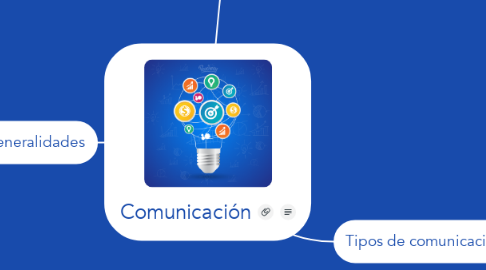
1. Generalidades
1.1. Cuatro funciones principales:
1.2. Controlar el comportamiento
1.3. Motivar
1.4. Expresar emociones
1.5. Informar
1.6. Elementos
1.6.1. Emisor (quien hace el mensaje)
1.6.2. Canal (medio por el que se da el mensaje)
1.6.3. Mensaje
1.6.4. Ruido (elementos que dificultan el envío o comprensión del mensaje)
1.6.5. Receptor (quien recibe el mensaje y a su vez da retroalimentación y/o respuesta)
1.6.6. La retroalimentación es clave, ya que es el elemento que garantiza una comunicación exitosa)
1.6.7. No tener en cuenta una respuesta puede provocar un mal entendimiento
2. Vias de comunicación
2.1. Hacia abajo (lideres se comunican con sus subordinados)
2.2. Hacia arriba (los subordinados se comunican con sus lideres)
2.3. Lateral (miembros de un mismo nivel jerárquico se comunican)
2.4. La comunicación lateral puede ayudar a la eficiencia del proceso laboral
2.5. La comunicación lateral también puede trastornar la jerarquía si se pasa por alto a los lideres)
3. Tipos de comunicación y más
3.1. Oral
3.1.1. Rapida
3.1.1.1. Do we have competitors and threats in these target markets with the proposed offerings?
3.1.1.2. What are our competitors doing and how are they positioning?
3.1.1.3. How do we position against each competitor?
3.1.2. Facil retroalimentación
3.1.2.1. Buyer Profile
3.1.2.1.1. Title
3.1.2.1.2. Industry
3.1.2.1.3. Geography
3.1.2.1.4. Business Size
3.1.2.2. Influencer Profile
3.1.2.3. User Profile
3.1.2.4. What do customers want and need?
3.1.2.5. What business problems do each of these customers have?
3.1.3. facilita la distorsión del mensaje
3.1.3.1. Which customers or sets of customers do we sell to?
3.1.3.2. What are the target market segments that we want to go after?
3.1.3.3. What are the distinct problems for each segment of the market?
3.1.4. Se presta para rumores y chismes
3.1.4.1. New Prospects
3.1.4.1.1. How much of each target segment have we penetrated?
3.1.4.1.2. How much opportunity is available in each target segment?
3.1.4.2. Existing Customers
3.1.4.2.1. Can we up-sell existing customers?
3.2. Escrita
3.2.1. Confiable y verificable
3.2.1.1. What are we selling?
3.2.1.2. Product Definition
3.2.1.3. Pricing
3.2.1.4. Packaging
3.2.1.5. Positioning
3.2.2. Toma más tiempo y se dificulta la retroalimentación
3.2.2.1. What is the Value Proposition to the Customer?
3.2.2.2. What pain are we solving?
3.3. No verbal
3.3.1. Completa los mensajes verbales
3.3.1.1. Revenue and P&L Forecast (5 Years)
3.3.1.2. Revenue should be split out quarterly
3.3.2. Puede complicar o mejorar el entendimiento de un mensaje
3.3.2.1. Should include a description of the costs in entering this business and profitability analysis
3.3.3. No tiene registro
3.3.3.1. P&L for the offer to include gross margin, net income and break even analysis.
3.4. Comunicación en la organización
3.4.1. Cadena (formal entre los superiores y subordinados)
3.4.1.1. What is the key messaging and positioning for the service offer? (Pain, alternatives, solution)
3.4.1.2. How do we communicate internally?
3.4.1.3. How do we communicate externally?
3.4.2. Rueda (depende de un miembro que se comunique con el resto)
3.4.2.1. Marketing Programs (Installed base versus new prospects)
3.4.2.2. Advertising (Publications, etc.)
3.4.2.3. Analyst Relations (Target Analysts)
3.4.2.4. Public Relations
3.4.2.5. Events (Trade shows, SEO/SEA, Seminars)
3.4.2.6. Webinars
3.4.3. Todos los canales (los miembros se comunican libremente con los otros)
3.4.3.1. How do we generate and qualify new leads for the target offer?
3.4.3.2. Prospect Lists
3.4.3.3. Key Questions to Ask
3.4.3.4. Sales Collateral
3.4.3.5. Presentations
3.4.3.6. Data Sheets
3.4.3.7. White Papers
3.4.3.8. ROI Tools
3.4.3.9. Other Sales Tools (web site, etc.)
3.5. Barreras en la comunicación
3.5.1. Filtrado (se distorsiona intencionalmente la información)
3.5.2. Percepción selectiva (se percibe del mensaje en base a necesidades o deseos personales en lugar del mensaje en sí)
3.5.3. Sobrecarga de información
3.5.4. Emociones ( el sentirse de X o Y forma, influirá en las percepción y envío de un mensaje)
3.5.5. comunicación aprensiva ( la persona evita enviar mensajes por medio de canales que no son los más convenientes y evita los que le generan ansiedad)
3.5.6. Cultura (tanto en lenguaje, genero, tradiciones, modismos)

